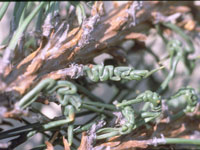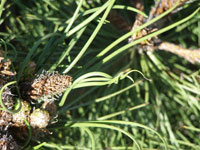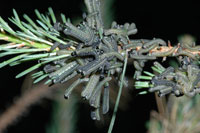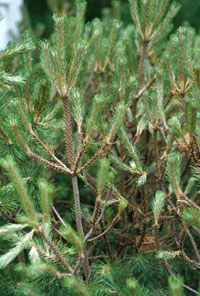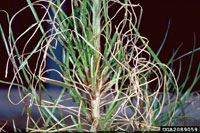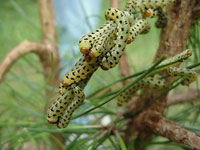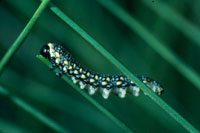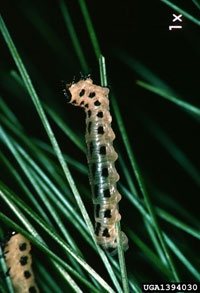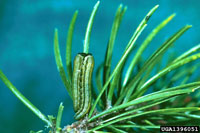Extension > Garden > Diagnose a problem > What's wrong with my plant? > Evergreen Trees and Shrubs > Pine > Distorted or deformed needles
Pine > Needles > Distorted or deformed needles
1 of 5
Growth regulator herbicide damage
(e.g. 2,4D or MCPP)
- Shoots may wilt or curl
- Needles stunted, twisted or misshapen but remain green
- If damage is severe, needles turn brown and fall off, branches may die
- Symptoms occur a few days to several weeks after herbicide application
- Dead or dying weeds expressing similar symptoms may be present nearby
- More information on Growth regulator herbicide damage
2 of 5
European pine sawfly
Neodiprion sertifer
- Larva feed only on old (last year's) needles
- Needles chewed on by young larvae become discolored and straw-like
- Larvae feed in colonies, feeding on one branch at time
- Active from May to June; one generation per year
- Feeds particularly on mugo, Scots, red and jack pines
- Larvae have shiny, black heads, grey, green body with dark green stripes; they are ¾ - 1 inch long when fully grown
- More information on European pine sawfly
3 of 5
Redheaded pine sawfly
Neodiprion lecontei
- Larvae feed on both old (last year's) and new needles
- Larvae feed in colonies, feeding one branch at a time
- Feeding by young larvae leave needles dry and straw-like
- Active between mid-June and late July and again from mid-August and late September; two generations occur per year (primarily in southern MN)
- Prefers young pine (5 - 20 foot tall); many species of pines are attacked, especially red and jack pines
- Larvae are ¾ to 1 inch long when fully grown; they are yellow with rows of black spots and reddish brown head
- More information on Redheaded pine sawfly
4 of 5
Introduced pine sawfly
Diprion similes
- Missing needles on old (last year's) needles; can also feed on new growth
- Needles chewed on by young larvae become discolored and straw-like
- Larvae feed in colonies, feeding on one branch at a time
- Active from late May/early June to early July and again from late July through early September; two generations per year
- Prefers white pine; will also feed on Scots, jack and red pine
- Larvae grow to ¾ - 1 inch in length; Larvae have black heads, a yellow-green body with a black double stripe and many yellow and black spots
- More information on Introduced pine sawfly
5 of 5
Misc. sawflies
(jack, red and white pine sawflies)
- Missing needles
- Needles may be completely consumed, partially eaten or become straw-like from feeding
- Larvae feed gregariously (i.e. in nonsocial groups), on new or old needle growth
- Larvae 1 inch long or less, green or yellowish-green with spots or stripes
- Different pine species favored by different sawflies but most pine are susceptible
- More information on Sawflies



